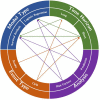A review of risk concepts and models for predicting the risk of primary stroke
- PMID: 36465691
- PMCID: PMC9710382
- DOI: 10.3389/fninf.2022.883762
A review of risk concepts and models for predicting the risk of primary stroke
Abstract
Predicting an individual's risk of primary stroke is an important tool that can help to lower the burden of stroke for both the individual and society. There are a number of risk models and risk scores in existence but no review or classification designed to help the reader better understand how models differ and the reasoning behind these differences. In this paper we review the existing literature on primary stroke risk prediction models. From our literature review we identify key similarities and differences in the existing models. We find that models can differ in a number of ways, including the event type, the type of analysis, the model type and the time horizon. Based on these similarities and differences we have created a set of questions and a system to help answer those questions that modelers and readers alike can use to help classify and better understand the existing models as well as help to make necessary decisions when creating a new model.
Keywords: epidemiology; machine learning; predictive modeling; risk; stroke.
Copyright © 2022 Hunter and Kelleher.
Conflict of interest statement
The authors declare that the research was conducted in the absence of any commercial or financial relationships that could be construed as a potential conflict of interest.
Figures


Similar articles
-
Machine Learning Models for Predicting Influential Factors of Early Outcomes in Acute Ischemic Stroke: Registry-Based Study.JMIR Med Inform. 2022 Mar 25;10(3):e32508. doi: 10.2196/32508. JMIR Med Inform. 2022. PMID: 35072631 Free PMC article.
-
Can Predictive Modeling Tools Identify Patients at High Risk of Prolonged Opioid Use After ACL Reconstruction?Clin Orthop Relat Res. 2020 Jul;478(7):0-1618. doi: 10.1097/CORR.0000000000001251. Clin Orthop Relat Res. 2020. PMID: 32282466 Free PMC article.
-
What Is the Accuracy of Three Different Machine Learning Techniques to Predict Clinical Outcomes After Shoulder Arthroplasty?Clin Orthop Relat Res. 2020 Oct;478(10):2351-2363. doi: 10.1097/CORR.0000000000001263. Clin Orthop Relat Res. 2020. PMID: 32332242 Free PMC article.
-
Clinical Risk Score for Predicting Recurrence Following a Cerebral Ischemic Event.Front Neurol. 2019 Nov 12;10:1106. doi: 10.3389/fneur.2019.01106. eCollection 2019. Front Neurol. 2019. PMID: 31781015 Free PMC article. Review.
-
Data-driven modeling and prediction of blood glucose dynamics: Machine learning applications in type 1 diabetes.Artif Intell Med. 2019 Jul;98:109-134. doi: 10.1016/j.artmed.2019.07.007. Epub 2019 Jul 26. Artif Intell Med. 2019. PMID: 31383477 Review.
Cited by
-
Optimizing breast cancer screening strategies for women with different BMI levels in Ghana: A simulation-based study on BMI-dependent tumor growth model.PLOS Glob Public Health. 2025 Jul 28;5(7):e0004953. doi: 10.1371/journal.pgph.0004953. eCollection 2025. PLOS Glob Public Health. 2025. PMID: 40720523 Free PMC article.
-
Determining the Proportionality of Ischemic Stroke Risk Factors to Age.J Cardiovasc Dev Dis. 2023 Jan 23;10(2):42. doi: 10.3390/jcdd10020042. J Cardiovasc Dev Dis. 2023. PMID: 36826538 Free PMC article.
References
-
- American Stroke Association. (2020). How Cardiovascular Stroke Risks Relate. Available online at: https://www.stroke.org/en/about-stroke/stroke-risk-factors/how-cardiovas... (accessed November 19, 2020).
Publication types
LinkOut - more resources
Full Text Sources

